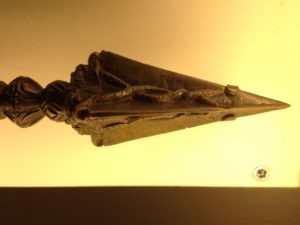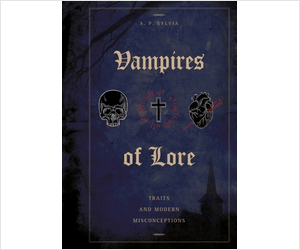Some time ago, as I was wandering through the Worcester Art Museum (WAM) in Worcester, MA, I came upon a gallery containing various antique weapons and armor. Clearly, these were some of the items from the museum’s Higgins Armory Collection. Towards the back of the room was a large display case with some drawers in its lower section. As I was examining their contents, I came across something unexpected. As I opened one of the drawers, I saw a small, carved face staring out. It was part of a rather elaborate bladed weapon. It turns out this collection contains a Tibetan ritual dagger.
These daggers may be referred to as phur-pa or phurba (in Tibetan), or kila (in Sanskrit). They have been used since ancient times in the spiritual practices of Tantric Buddhism. As such, they aren’t intended to be physical weapons. Traditionally, the blade of such a dagger has three edges, representing the three root poisons (ignorance, greed, and aggression), as well as the three spirit worlds. Nagas (serpents) may be portrayed on the blade, symbolizing the six perfections. The base of the blade may be designed to look like the heads of mythical creatures (such as garudas, which are bird-like entities, in the case of the WAM’s dagger). The top of the handle often features three faces depicting Buddhist deities. Overall, the handle represents wisdom while the blade signifies method.
In the beliefs of Tantric Buddhism, the phurba has a variety of uses. Perhaps most well known is its ability to banish demons. The blade may be ritually plunged into the ground, or a bowl filled with salt, rice, or grain. This action would pin and dispel evil. While the blade end is used for “wrathful” actions, the head of the dagger is used for blessings. Additionally, the phurba is a tool for meditation.
The dagger in the Worcester Art Museum’s collection is quite striking. It’s made of cast bronze and dates to the 1800s. It can be found in Gallery 109. The museum has an entrance fee, while parking is free. (Please note, at the time of writing this, the museum is closed due to the COVID-19 outbreak.) Of course, the phurba is just one of the many wonderful objects this museum has on display. If you do visit, make sure you give yourself enough time to explore the collection.
Location:
55 Salisbury Street
Worcester, MA 01609
Official site: https://www.worcesterart.org/
Sources:
Kane, Lee. “Phurba or Kila: the most potent of wrathful ritual implements in Vajrayana Buddhism, symbolizes the Karma activity of the Buddhas.” Budda Weekly. https://buddhaweekly.com/phurba-kila-potent-wrathful-ritual-implements-vajrayana-buddhism-symbolizes-karma-activity-buddhas/.
“Phur-pa (ritual dagger).” The Worcester Art Museum. https://worcester.emuseum.com/objects/48003/phurpa-ritual-dagger?ctx=6f0c58f6-765e-4b56-9de3-40c8d6079a47&idx=0.
“Phurba Dagger.” The Metropolitan Museum of Art. https://www.metmuseum.org/art/collection/search/75827.
“Phurba Dagger- The Tibetan Buddhist Ritual Instrument.” Hinky Imports. http://www.hinkyimport.com/phurba-dagger-the-tibetan-buddhist-ritual-instrument/.
Written by A. P. Sylvia




